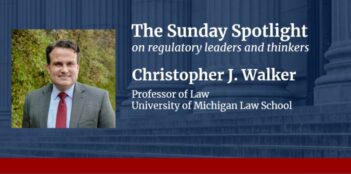
The Trump Administration has invoked recent Supreme Court decisions to justify unraveling normal rulemaking procedures.
It is hard to believe it was less than a year ago that the U.S. Supreme Court decided what then seemed like the biggest news for administrative law in living memory: the overruling of Chevron. In ditching this 40-year-old precedent that called for courts to give deference to agencies’ interpretations of key statutory provisions, the Supreme Court fundamentally unsettled what we have called the “administrative governance game”—the complex, interdependent system that emerges from the competition of multiple institutional and individual players over the administration of the federal government.
With the ink barely dry on the Court’s opinion in Loper Bright Enterprises v. Raimondo, we are beginning to see just how unsettled, and how unpredictable, the administrative governance game can be in a post-Loper Bright world. With a new memorandum, “Directing the Repeal of Unlawful Regulations,” President Donald J. Trump last week made a bold new move, invoking Loper Bright—as well as other recent administrative law innovations, such as the “major questions doctrine” from West Virginia v. EPA—to claim the authority to rescind potentially scores of existing regulations without even following standard administrative procedures.
Under the recent presidential memorandum, once an agency determines that a regulation is on its face unlawful “under” Loper Bright and other recent administrative law decisions, it must “finalize rules” rescinding those regulations “without notice and comment.” This means agencies would neither publish notices of proposed rulemakings as called for under Section 553 of the Administrative Procedure Act (APA) nor elicit public feedback on those proposals, also as provided for under the APA. Depending on how readily and extensively agencies arrive at a conclusion that existing regulations are no longer legally justified, this new “review-and-repeal” initiative could amount to a presidential power to force the recission of large numbers of existing regulations that, up to this point, would presumptively have been required to be rescinded only with deliberate care that took into account public input.
We do not know for certain, of course, that a second Trump Administration would not still have sought to jettison the notice-and-comment process even if Chevron had remained intact. Nevertheless, it is telling that Loper Bright stood at the very top of the list of Supreme Court decisions in the President’s recent “Directing the Repeal” memorandum. Loper Bright also featured prominently in a November 2024 op-ed in The Wall Street Journal by Elon Musk and Vivek Ramaswamy, in which they claimed that the Court’s decision in that case, along with the decision in West Virginia v EPA, gave the so-called Department of Government Efficiency, more widely known simply as DOGE, a mandate to prod agencies to cut their regulations.
It is striking how Loper Bright and the major questions doctrine are being used this way when they were ostensibly premised on the Court’s conservative justices’ sense that agencies had too much power and were playing too great of a role in interpreting statutes. And now comes along a presidential memorandum that compels agencies to start repealing regulations based on their own, presumably changed, interpretations of statutes—and without following normal procedures to boot. All this in the name of Loper Bright.
In Loper Bright, the Court ostensibly said that statutory interpretation was to be left up to the courts. The majority opinion in that case offered strong rhetoric imploring judges to exercise stringent review of agency decisions so as to constrain the steady accumulation of executive power and to put a stop to agencies’ ability to keep changing how they interpret the statutes they administer.
The Court recounted with some disdain, for example, the history of flip-flops on the regulation of broadband internet services across each of the last four presidential administrations, concluding that Chevron had “engendered constant uncertainty and convulsive change even when the statute at issue itself remained unchanged.”
Likewise, even though the major questions doctrine is often viewed as an offshoot of the moribund—for now—nondelegation doctrine, some observers have pointed out that the better way to understand its requirement of a clear congressional delegation of authority on major issues as “not so much … a way of preventing Congress from giving away too much power as a way to prevent Presidents from snatching powers they were not given.”
But as President Trump’s recent memorandum reveals—and as we suggested recently in an article in the Administrative Law Review on Loper Bright’s “great unsettling”—whatever the intent the justices might have had in overturning Chevron in an effort to constrain agencies’ interpretive power, the real implications might turn out to be the opposite. One is tempted to say, be careful what one wishes for. If Loper Bright’s majority thought it was moving to limit agencies from going their own way in interpreting their statutes, it is remarkable to see the Court’s decision now invoked as a justification for a bold assertion of executive power to make sweeping regulatory change based on agencies’ own statutory interpretations—and without even going through the notice-and-comment process.
The ultimate impact and implications of this latest move by the Trump Administration remain to be seen. It could very well be that Trump’s first-mover advantage to weaponize Loper Bright and the major questions doctrine in pursuit of a deregulatory agenda will work in the short run to the advantage of the ideological preferences of conservative politicians and judges. But if Loper Bright has encouraged this Administration to abandon basic administrative procedures, the Court’s decision may well prove in the future to be a boon to agency power more broadly as procedural constraints on agency rulemaking atrophy.
We hasten to add, of course, that it is also possible that President Trump’s aggressive move to call for agencies to abandon notice-and-comment rulemaking will set off countermoves by any number of other players in the administrative governance game and that these countermoves might ultimately rein in President Trump or future Presidents and their administrations. As we discussed in our recent article, it is difficult to know how the dust will settle now that Loper Bright has shaken up a once-stable governing equilibrium. But President Trump’s recent memorandum is a clear indication that we are, in fact, in the midst of a significant and contentious recalibration of how governmental power is exercised. And at the center of this recalibration—either as motivation or as justificatory cover—sits the Supreme Court’s decision in Loper Bright. The symbolic resonance of this decision is hard to overstate when it is being cited in an effort by the current Administration to effectuate dramatic policy changes without following regular order—changes that might have seemed unfathomable a year ago. We may all do well to pause and ponder what further changes Loper Bright’s “great unsettling” of the nation’s governing equilibrium might bring about over the next year—and beyond.
An earlier version of this essay first appeared in the Yale Journal on Regulation’s blog, Notice and Comment.





